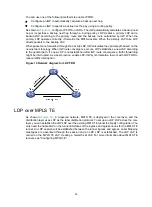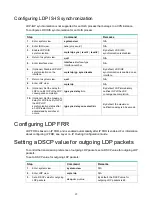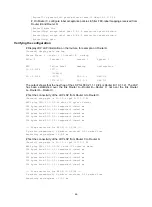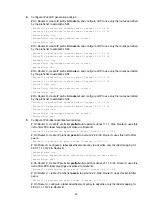
37
Configuring LDP IS-IS synchronization
LDP-IGP synchronization is not supported for an IS-IS process that belongs to a VPN instance.
To configure LDP-ISIS synchronization for an IS-IS process:
Step Command
Remarks
1.
Enter system view.
system-view
N/A
2.
Enter IS-IS view.
isis
[
process-id
]
N/A
3.
Enable LDP-ISIS
synchronization.
mpls ldp sync
[
level-1
|
level-2
]
By default, LDP-ISIS
synchronization is disabled.
4.
Return to system view.
quit
N/A
5.
Enter interface view.
interface
interface-type
interface-number
N/A
6.
(Optional.) Disable LDP-IGP
synchronization on the
interface.
mpls ldp igp sync disable
By default, LDP-IGP
synchronization is enabled on an
interface.
7.
Return to system view.
quit
N/A
8.
Enter LDP view.
mpls ldp
N/A
9.
(Optional.) Set the delay for
LDP to notify IGP of the LDP
convergence completion.
igp sync delay
time
By default, LDP immediately
notifies IGP of the LDP
convergence completion.
10.
(Optional.) Set the maximum
delay for LDP to notify IGP of
the LDP-IGP
synchronization status after
an LDP restart or an
active/standby switchover
occurs.
igp sync delay
on-restart
time
By default, the maximum
notification delay is 90 seconds.
Configuring LDP FRR
LDP FRR is based on IP FRR, and is enabled automatically after IP FRR is enabled. For information
about configuring IP FRR, see
Layer 3—IP Routing Configuration Guide
.
Setting a DSCP value for outgoing LDP packets
To control the transmission preference of outgoing LDP packets, set a DSCP value for outgoing LDP
packets.
To set a DSCP value for outgoing LDP packets:
Step Command
Remarks
1.
Enter system view.
system-view
N/A
2.
Enter LDP view.
mpls ldp
N/A
3.
Set a DSCP value for outgoing
LDP packets.
dscp
dscp-value
By default, the DSCP value for
outgoing LDP packets is 48.
















































